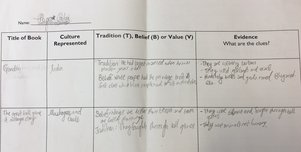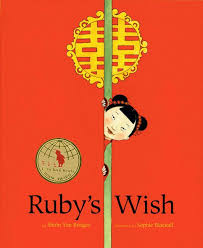This week we welcomed our Year 4 classes who are learning about culture and identity. Their current unit of inquiry is People express identity and culture through story and is under the theme of 'How we express ourselves'.
As part of a provocation I invited students up to the Library to evaluate what we had in terms of diversity in picture books. Students spent 10-15 mins looking through 60 tubs of picture books and pulling out examples of books where we could learn something about another culture.
I used "Ruby's Wish" by Shirin Yim Bridges as an example and we followed three steps to look for clues:
1. Look at the cover - Look for visual clues including colour, symbols, images as well as the title for hints. 2. Read the blurb - Look at the back and inside covers to read the synopsis of the story "If you walk down a certain road in a certain city in old China, past the pet market with its yellow-and-green ricebirds in their bamboo cages and the goldfish in their porcelain bowls, you will find a little girl named Ruby. Ruby is unlike most girls of her time. Instead of getting married, Ruby is determined to attend university when she grows up, just like the boys in her family". 3. Picture Walk - Browse through the pictures to look for more hints and clues and then stop and read a few pages.

Students used a simple graphic organiser to collect and record the data. Students were asked to try and find examples of traditions, beliefs and values that may be evidenced in the story through text or pictures. Ruby's Wish had many and I recorded student ideas on the board as an example.
Students were then asked to display all of the books that they found within the Picture Book collection. By the end of the browse, we had almost 100 books on display. Many students enjoyed the book hunt aspect and then became immersed in the stories they had found. Some shared interesting details of what they had discovered in other excellent examples. We came to the conclusion that reading stories like these gave us valuable insights into different cultures.
Identity I asked students to look again at the collection of books to see if they could find any that represented their own culture(s) or an aspect of their identity that they could connect with. Our students are from a variety of countries and I was aware that I couldn't use the word home in a narrow way. As students were walking around I heard some interesting comments that I think we can come back to such as "We have a lot of Chinese culture books" or "I can't find a book that interest me. There is not one about my culture".
Follow Up I asked the Library Assistants to collate a list of all books found from the 4 classes. This can be used as hard data for the students to sort and analyse. It can then be used to compare and reflect upon initial perceptions and feelings about the collection. All books will be sent to the Y4 shared area where they can continue to be shared and read in support of the classroom teachers work with the unit of inquiry. We found some Read Around the World stickers leftover from a previous Book Week theme and stuck them onto the covers for easy identification in the future.
Action I am hoping that as part of their student inquiry student will indeed recommend books that we can buy to increase the diversity in our collection. Without telling them to do so I have publicised our wishlist process so that students know how to recommend books. As the unit is under the How we express ourselves theme, I am also hoping that students will be writing their own stories that focus on aspects of their own cultures that will give us an opportunity to learn more about each other and become more internationally-minded. Student created work is always shared in the main entrance to the Library so that all students can view it.







Comments